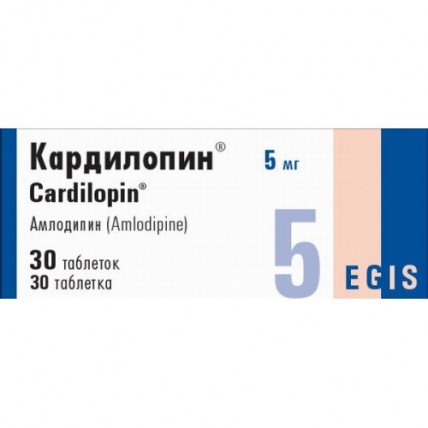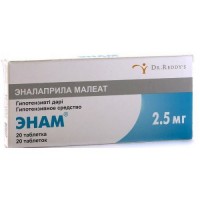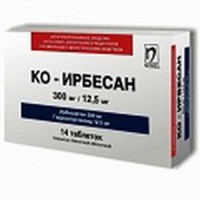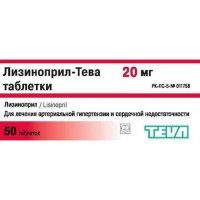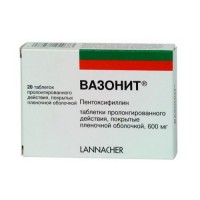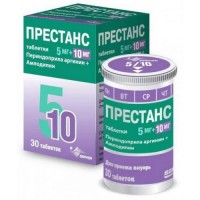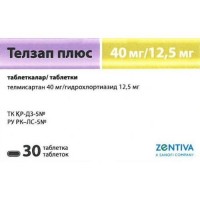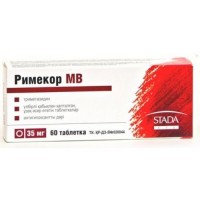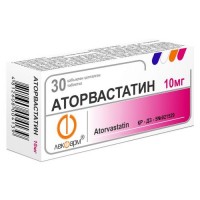The instruction for medical use of KARDILOPIN® medicine the Trade name of Kardilopin® the International unlicensed name Amlodipin Lekarstvennaya a form of the Tablet of 2.5 mg, 5 mg, 10 mg Structure One tablet contains active agent - 3.475 mg, 6.95 mg, 13.90 mg of an amlodipin of the besilat (2.5 mg, 5 mg, 10 mg are equivalent to an amlodipin), excipients: microcrystalline cellulose, sodium of starch glikolit (type A), magnesium stearate, silicon dioxide colloidal anhydrous. The description of White, almost white or yellow-white color, round tablets, flat with a facet, with an engraving in the form of the stylized letter E on one and number 251 on other party, without or almost flavourless (for a dosage of 2.5 mg). White, almost white or yellow-white color, round tablets, flat with a facet, with an engraving in the form of the stylized letter E on one and number 252 on other party, without or almost flavourless (for a dosage of 5 mg). White, almost white or yellow-white color, round tablets, flat with a facet, with an engraving in the form of the stylized letter E on one and number 253 on other party, without or almost flavourless (for a dosage of 10 mg). Pharmacotherapeutic group Blockers of slow calcium channels. Blockers of slow calcium channels selection. Dihydropyridinic derivatives. Amlodipin the ATX C08CA01 Code the Pharmacological Pharmacokinetics Amlodipin properties is well soaked up from digestive tract after intake therapeutic dosed the Maximum concentration of drug in blood it is noted in 6-12 hours. The accompanying meal does not influence absorption of an amlodipin. The absolute bioavailability is about 64-80%. Linking with proteins of plasma makes 93-98%. Amlodipin is well distributed in an organism (the seeming distribution volume - 21 l/kg) that is a basis of long elimination half-life and a possibility of single use in day. Equilibrium concentration in blood plasma (5 – 15 ng/ml) is reached in 7–8 days after the beginning of administration of drug. Amlodipin is exposed to intensive metabolism in a liver. About 90% of the accepted dose will be transformed to inactive derivatives of pyridine. About 10% of the accepted dose are removed with urine in not changed look. About 60% of quantity of inactive metabolites are removed with urine and 20-25% through intestines. Curve concentration time in blood plasma has two-phase character. Final elimination half-life makes about 35-50 hours that allows to administer the drug once a day. The clearance of drug and all organism is 7 ml/min. (the patient weighing 60 kg has 25 l/h). At patients of advanced age the clearance of drug is 19 l/h of all organism. Special groups of patients Patients with abnormal liver functions Are available only limited data on use of an amlodipin for patients with an abnormal liver function. At such patients the clearance of an amlodipin goes down that leads to lengthening of time of semi-removal and increase in AUC approximately for 40-60%. Elderly patients At patients of advanced age and young people Tmax value are similar. At patients of advanced age the clearance of an amlodipin goes down that leads to increase in AUC and lengthening of time of semi-removal. Patients with stagnant heart failure have an increase in AUC and lengthening of time of semi-removal corresponded to the values expected for age groups. Patients with renal failures the Pharmacokinetics of an amlodipin does not change in a renal failure. The pharmacodynamics Amlodipin (a blocker of slow calcium channels or the antagonist of calcium of dihydropyridinic group) oppresses transmembrane current of calcium ions in cardiomyocytes and smooth muscle cells of vessels. The mechanism of antihypertensive action of Kardilopin is caused by the direct relaxing impact on smooth muscle cells of vessels and the subsequent decrease in peripheric vascular resistance. The mechanism of anti-anginal action is connected with ability of an amlodipin to cause: 1. expansion of peripheral arterioles and reduction of the general peripheric resistance (afterload). Amlodipin does not cause reflex tachycardia that reduces a metabolic cost of a myocardium and its oxygen requirement, 2. expansion of large coronary arteries and arterioles, both in normal, and in ischemic zones that improves oxygen delivery, both to healthy, and to ischemic sites of a myocardium. It provides intake of oxygen to a myocardium at spasms of coronary arteries (Prinsmetal's stenocardia or alternative stenocardia). At patients with arterial hypertension the administration of drug is followed by clinically significant lowering of arterial pressure within a day once a day. Due to the slow development of action, sudden falling of arterial blood pressure is improbable. At patients with stenocardia the single daily administration of drug leads to increase in tolerance of physical activity and delays development of the next attack of stenocardia and significant depression (1 mm) of ST segment, reduces the frequency of attacks of stenocardia and the need for reception of Tabulettaes Nitroglycerini. Administration of drug does not change the level of lipids, sugar and uric acid in blood serum, thus, drug can be used at patients with bronchial asthma, diabetes and gout. The hemodynamic researches and the controlled clinical trials based on physical activities at patients with heart failure of the functional classes II-IV on classification of NYHA showed that use of an amlodipin did not lead to deterioration in a physical state what the shipping of physical activities, values of fraction of emission and clinical symptomatology testifies to. In long, placebo - the controlled research with the subsequent observation (PRAISE-2) was established that at patients with heart failure of the functional classes III-IV on classification of NYHA without the clinical symptoms or objective symptoms of an ischemic disease receiving stable doses of APF inhibitors, cardiac glycosides and diuretics, use of an amlodipin did not influence cardiovascular mortality. However, in the same population of patients at use of an amlodipin it was more often reported about edematization of lungs. Indications - arterial hypertension - stable chronic stenocardia - vasospastic stenocardia (Prinsmetal's stenocardia) the Route of administration and doses of the Tablet for intake. A pill should be taken at the same time day, washing down with a glass of water, irrespective of meal. It is not necessary to accept Kardilopin with grapefruit juice. At treatment of arterial hypertension or stenocardia the recommended initial dose makes 5 mg once a day. Taking into account reaction of the patient the initial dose can be increased up to 10 mg once a day. At patients with arterial hypertension Kardilopin's dose is not changed in case of its simultaneous use with thiazide diuretics, β-blockers and inhibitors of angiotensin-converting enzyme. In stenocardia Kardilopin it is possible to apply as monotherapy or in a combination with other anti-anginal medicines at the patients who are not reacting to treatment by nitrates or to adequate doses of β-blockers. Patients of advanced age Patients of advanced age well transferred Kadilopin appointed in the same doses as to young patients. To patients of advanced age drug is appointed in the usual recommended doses, however at increase in doses it is necessary to be careful. Patients with an abnormal liver function Are absent recommendations about dosing at patients with easy and average degree of an abnormal liver function therefore selection of a dose demands care. In an initiation of treatment it is necessary to appoint the lowest dose of 2.5 mg. The pharmacokinetics of an amlodipin was not investigated at patients with heavy abnormal liver functions. Patients with heavy abnormal liver functions have a treatment amlodipiny it is necessary to begin with the lowest doses with the subsequent slow titration of a dose. Patients with a renal failure of Change of concentration of an amlodipin in plasma do not correlate with degree of a renal failure therefore the usual mode of dosing is recommended. Amlodipin is not brought at a hemodialysis. Children and teenagers aged from 6 up to 17 years the Recommended initial dose at children aged from 6 up to 17 years makes 2.5 mg once a day. If the target value of arterial blood pressure is not reached in 4 weeks of treatment, the dose can be raised to 5 mg once a day. The doses given about use, exceeding 5 mg a day at children is absent. Data on use of drug for children are younger than 6 years are absent. Side effects Often (≥1/100 – & lt, 1/10) - drowsiness, dizziness, a headache (especially in an initiation of treatment), fatigue - heart consciousness - inflows - an abdominal pain, nausea - hypostases, hypostasis of anklebones Infrequently (≥1/1000 – & lt, 1/100) - insomnia, changes of mood (including disturbing states), a depression - a tremor, disturbance of flavoring feelings, a syncope, a gipoesteziya, paresthesia - disorders of vision (including a diplopia) - hypotension - short wind, rhinitis - vomiting, dryness in a mouth, dyspepsia, change of function of intestines (including diarrhea and constipations) - an alopecia, a purpura, discoloration of skin, the increased sweating, an itching, rash, a dieback - an arthralgia, myalgia, muscular spasms, a dorsodynia - urination disturbances, a nocturia, the increased frequency of urinations - impotence, a gynecomastia - a stethalgia, an asthenia, pain, an indisposition - increase or degrowth of chalk Is rare (≥1/10,000 – & lt, 1/1000) - confusion of consciousness Is very rare (≥1/10,000) - allergic reactions - a leukopenia, a purpura, thrombocytopenia - a hyperglycemia - a hypertension, peripheral neuropathy - a myocardial infarction, arrhythmias (including bradycardia, ventricular tachycardia and fibrillation of auricles) - a vasculitis - cough - pancreatitis, gastritis, a hyperplasia of gums - hepatitis, jaundice, increase in level of liver enzymes * - a Quincke's disease, a multiformny erythema, a small tortoiseshell, exfoliative dermatitis, Stephens-Johnson's syndrome, a Quincke's edema, photosensitivity * In most cases together with a cholestasia. Extrapyramidal symptoms were in some cases observed. Contraindications - hypersensitivity to dihydropyridines and/or any excipients - heavy hypotension - shock (including and cardiogenic shock) - hemodynamically unstable heart failure after a myocardial infarction - clinically significant stenosis of an aorta - children's age up to 6 years - pregnancy and the period of a lactation CYP3A4 cytochrome Inhibitors Simultaneous use of Kardilopin with powerful inhibitors of CYP3A4 cytochrome (for example, with protease inhibitors, azolovy antifungal drugs, macroleads, such as erythromycin or klaritromitsin or with verapamil and diltiazem) can lead Medicinal interactions to substantial increase of concentration of an amlodipin in blood plasma. Patients of advanced age can have more expressed these pharmacokinetic changes. Therefore they need clinical observation and specification of a dose. Inductors of CYP3A4 cytochrome there Is no information on quantitative effects of inductors of CYP3A4 cytochrome on amlodipin. At simultaneous use of such drugs (for example, rifampicin, a St. John's wort) with amlodipiny the concentration of an amlodipin in plasma can go down. Amlodipin it is necessary to appoint with care in a combination with CYP3A4 cytochrome inductors. Use of an amlodipin with greyprfruty or with juice of grapefruit is not recommended as at some patients its bioavailability can increase, leading to more significant lowering of arterial pressure. Dantrolen (infusion) Due to the risk of development of a hyperpotassemia it is necessary to avoid simultaneous use of a dantrolen with blockers of calcium channels at the patients inclined to a malignant hyperthermia and at treatment of a malignant hyperthermia. The effect of an amlodipin on other medicines Hypotensive effect of an amlodipin can enhance antihypertensive effect of other drugs reducing arterial blood pressure. Amlodipin does not influence pharmacokinetics of an atorvastatin, digoxin, warfarin or cyclosporine. The special instructions Efficiency and safety of an amlodipin in hypertensive crisis it is unknown. Researches of a hemodynamics and clinical trials at patients with heart failure of the II-III class on the New York classification did not show deterioration in shipping of physical activity, clinical symptoms or decrease in fraction of emission of a left ventricle at reception of an amlodipin. The results received at patients with heart failure of the III-IV class on the New York classification (research PRAISE) showed that amlodipin did not increase the frequency of cardiovascular diseases or mortality from them at its addition to treatment by APF inhibitors, diuretics and digoxin. Patients with heart failure the Patients with heart failure should appoint treatment with care. In long, placebo - the controlled research of patients with heavy heart failure (NYHA class III and IV) the frequency of a fluid lungs was higher in the group receiving amlodipin in comparison with placebo. Blockers of calcium channels including Kardilopin, patients should appoint with care with stagnant heart failure as these drugs can increase risk of developing further cardiovascular diseases and mortality. Patients with an abnormal liver function At patients with an abnormal liver function time of semi-removal of an amlodipin and AUC value increases, recommendations about the dosing mode at these patients are absent. Such patients should begin treatment by Kardilopin with the lowest doses, showing care both in an initiation of treatment, and at increase in a dose. With heavy an abnormal liver function slower titration of doses and careful medical control is necessary for patients. Features of influence of medicine on ability of driving or potentially dangerous mechanisms. Kardilopin's reception can cause dizziness and drowsiness in this connection, patients are recommended to abstain from control of vehicles and the special equipment. Overdose Symptoms: symptoms of a peripheral vazodilatation, reflex tachycardia. There are messages about expressed and, perhaps, long hypotension, including shock from the death. Treatment: there is no specific antidote. Carry out gastric lavage. Use of activated carbon within 2 hours after acceptance of an amlodipin lowered its absorption. At development of clinically significant arterial hypotension, holding the actions directed to maintenance of function of a cardiovascular system including monitoring of indicators of heart and lungs, sublime position of the lower extremities, control of volume of the circulating blood and a diuresis is required. And also intensive symptomatic treatment: administration of vasoconstrictors for restoration of a vascular tone and arterial blood pressure, intravenous administration of calcium of a gluconate reduces symptoms of blockade of calcium channels. Amlodipin well contacts proteins of blood plasma in this connection, the hemodialysis is not applied. A form of release and packing On 10 tablets in blister strip packaging from a film of PVH/PVDH/of aluminum foil. On 3 blister strip packagings together with the instruction for medical use in the state and Russian languages in a cardboard pack. To Store storage conditions at a temperature not above 25 °C, in the place protected from light. To store out of children's reach! Not to apply a period of storage of 5 years after an expiration date. Prescription status According to the prescription BUDAPEST CJSC EGIS PHARMACEUTICAL PLANT Producer 1106, st. Keresturi, 30-38 Hungary Phone number: (36-1) 803-5555, fax: (36-1) 803-5529 Owner of the registration certificate of CJSC Pharmaceutical Plant Egis, Hungary the Address of the organization accepting in the territory of the Republic of Kazakhstan claims from consumers on quality of products (goods) Representation in RK CJSC EGIS Pharmaceutical Plant 050060, Almaty, Zharokov St. of 286 G ph. + 7 (727) 247 63 34, + 7 (727) 247 63 33, fax: + 7 (727) 247 61 41, e-mail:
To Develop egis@egis.kz
To Develop egis@egis.kz
